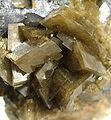Carbonates
Carbonates (technical language) or carbonates are the inorganic salts and organic esters of the by definition inorganic carbonic acid (H 2 CO 3 ). Two series of salts are derived from the biprotonic (dibasic) acid, namely the hydrogen carbonates , which are also called primary carbonates, with the general formula M I HCO 3 and the secondary carbonates, with the general formula M I 2 CO 3 . The secondary carbonates are based on the doubly negatively charged carbonate ion CO 3 2− .
The esters of carbonic acid with the general structural formula R 1 −O − C (= O) −O − R 2 , where R 1 and R 2 are carbon-containing alkyl or aryl radicals, are also called carbonates and are described under carbonic acid esters . Polymeric carbonates have the general structural formula (O − R − O − C (= O) -) n and are treated under polycarbonates .
The orthocarbonic acid esters with the structural formula C (OR) 4 are derived from orthocarbonic acid (C (OH) 4 ), which does not exist in free form .
properties
The carbonate anion is completely planar, with 120 ° bond angles between the individual oxygen atoms. The distances of all three O atoms to the central carbon atom are the same and, at around 130 pm, lie between the length of CO single bonds (143 pm) and C = O double bonds (123 pm).
Carbonates are ionic salts and therefore usually crystalline solids at room temperature. The carbonate anion does not introduce any color of its own into the compounds, so that their color may be determined by the relevant cation . Carbonates are odorless. With the exception of the alkali carbonates, they are only slightly soluble in water, so that most of the metal ions are precipitated in aqueous solution when they react with alkali carbonates.
Occurrence
Carbonates occur everywhere in nature, mostly in the form of various minerals . In the classification of minerals according to Strunz (9th edition) , they form a common mineral class together with the related nitrates . In the outdated 8th edition of the Strunz system and in the Dana system of minerals used in the English-speaking world , the borates are also included in the class.
Important or well-known representatives of the carbonates include the barium carbonate witherite ; the calcium carbonates aragonite , calcite and vaterite ; the iron carbonate siderite ( iron spar ); the basic copper carbonates azurite and malachite ; the magnesium carbonate magnesite ; the manganese carbonate rhodochrosite ( manganese spar ); the sodium carbonates gaylussite , natrite , pirssonite , soda and trona , the zinc carbonate smithsonite ( zinc spar ) and bastnäsite as raw material for the extraction of rare earth metals . Further representatives of the carbonate family are dolomite ( calcium magnesium carbonate ) and “potash” ( potassium carbonate ), which is only known in nature as a mixture of substances . The total amount of carbon contained in the lithosphere is about 2.9 · 10 16 t .
Furthermore, the hydrosphere of the seas, lakes and rivers also contains large amounts of dissolved carbonates and almost all living things contain dissolved carbonates or use insoluble carbonates as a structural substance. From a geological point of view, carbonates occur mostly as sedimentary rocks ( limestone ), more rarely metamorphic rocks or even igneous rocks ( carbonatite ).
Rhodochrosite (red)
Violet to pink smithsonite
Reactions
- Reaction between carbonic acid and carbonate:
- Calcium carbonate reacts with water and carbon dioxide to form calcium hydrogen carbonate .
This reaction takes place when limestone dissolves in carbonated groundwater. It is the origin of water hardness .
- Dissociation in water:
- Magnesium carbonate dissociates into a magnesium ion and a carbonate ion.
- Disintegration on heating:
- Calcium carbonate breaks down into calcium oxide and carbon dioxide.
This is the reaction in the manufacture of quicklime .
See also: carbonate-silicate cycle
Basic reaction
The carbonate ions react with water to form hydrogen carbonate and hydroxide ions. It is an acid-base reaction .
Although this equilibrium is on the left, the increased concentration of hydroxide ions means that carbonate solutions have a clearly alkaline reaction .
proof
Carbonate ions (CO 3 2− ) can be detected by adding hydrochloric acid, which produces carbon dioxide :
Carbon dioxide gas is fed into the detection reagent lime or barite water . There it creates a white cloudiness of calcium or barium carbonate :
- Barium hydroxide and carbon dioxide react to form barium carbonate and water
The quantitative detection of low carbonate concentrations in water is carried out together with the determination of hydrogen carbonates, often by titration with hydrochloric acid ("SBV"): if the measured material has a pH value above 8.3 at the beginning, the consumption of hydrochloric acid is up to pH 8.3 equivalent to the carbonate concentration. The further acid consumption until a pH of 4.3 is reached corresponds to the sum of carbonate and hydrogen carbonate. In the case of water with a pH value below 8.3, titrate only up to 4.3 (only hydrogen carbonate) and calculate the original, then very low proportion of carbonate ions from the dissociation equilibrium of the carbonic acid.
Carbonates and hydrogen carbonates can also be determined by ion HPLC or by capillary electrophoresis . In both cases, a “total carbonate” is determined and the components carbonate, hydrogen carbonate and “free carbonic acid” are calculated from the dissociation equilibrium of the carbonic acid, taking into account the pH value, ionic strength and temperature.
Web links
- Carbonate (varalten: carbonate). In: Mineralienatlas Lexikon. Stefan Schorn u. a., accessed on October 14, 2019 .
Individual evidence
- ^ A b A. F. Holleman , E. Wiberg , N. Wiberg : Textbook of Inorganic Chemistry . 101st edition. Walter de Gruyter, Berlin 1995, ISBN 3-11-012641-9 .
- ↑ carbonate. Spektrum.de , December 4, 2014, accessed October 14, 2019 .

















